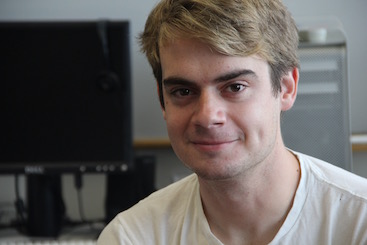In this section, Dr. Kurt Fendt and teaching assistant, Andrew Kelleher Stuhl, discuss the digital humanities course projects that students complete. They note that the projects are an opportunity for students to apply what they’ve learned during the first half of the semester about core concepts in digital humanities. They also share their insights about using surveys to help students form collaborative project groups.
An Opportunity to Apply Core Concepts in Digital Humanities

Andrew Kelleher Stuhl, Teaching Assistant for CMS.633 Digital Humanities (Image by MIT OpenCourseWare).
In the first half of the semester, students read theoretical texts and we discuss core concepts in digital humanities, such as data representation, digital archives, information visualization, and user interaction. Our goal is to get students thinking about data, how we turn humanities documents into data, and how approaches like geographical mapping and timeline work can shape how we understand those data. We engage them in exercises, such as data scraping, named entity recognition, and basic data visualizations, so they can understand these concepts more deeply.
During the second half of the semester, students apply the concepts they’ve learned in real-world contexts through the development of digital humanities projects that meet scholarly, educational, or public needs. In developing their projects, we ask students to follow a process based in design thinking. First they identify the specific problems they want to solve, define their target audiences, and then talk to possible stakeholders (e.g. museums) about specific needs or restrictions. The idea is to then create a project concept that uses novel approaches by leveraging a variety of digital tools and techniques to engage an audience more deeply with the humanities.
One group, for instance, created a project situated within the context of the Berklee College of Music. They interviewed students and other community members on campus. Ultimately, they identified a digital project introduced by a sound artist who had been a guest speaker in the course. This mobile project overlapped with some of the methodology they were hoping to use in their own work. They engaged in multiple conversations with the guest speaker in order to identify what would be unique about their approach, and what components of the artist’s tools they could repurpose for their own project.
Another group did a location-based project based on tracking one’s path through a museum, annotating it through comments, and then sharing that path with other museum visitors. They visited the Museum of Fine Arts several times, interviewed visitors and staff there, and used that feedback to develop the project.
"The idea is to [. . .] create a project concept that uses novel approaches by leveraging a variety of digital tools and techniques to engage an audience more deeply with the humanities."
Working Collaboratively
We require students to work as groups on their digital humanities projects because it mirrors how digital humanists typically work in the field: collaboratively. We’re fortunate that students come to the course with such different skill sets, because it allows us to model how digital humanists work together across disciplines.
Typically, students form their own groups, with some nudging from the instructors when necessary. For instance, some students already know each other and have an idea for a project, and those people quickly form groups. Other students are less certain and are still experimenting with different ideas. We conduct a survey fairly early in the semester that asks students to identify the technologies and fields with which they have the most experience, the skills they’d be most excited about lending to a team project, as well as the skills they are hoping to learn by taking the course. We’ve found that students’ responses to these survey questions help us steer students toward each other who would collaborate well together.
Of course, we always have more project pitches than we can actually realize. Some students are unable to find support for their proposed project ideas. When that happens, we try to help them think about concepts that might push their original ideas in different directions. So the pitches and projects change depending on how the groups form.










